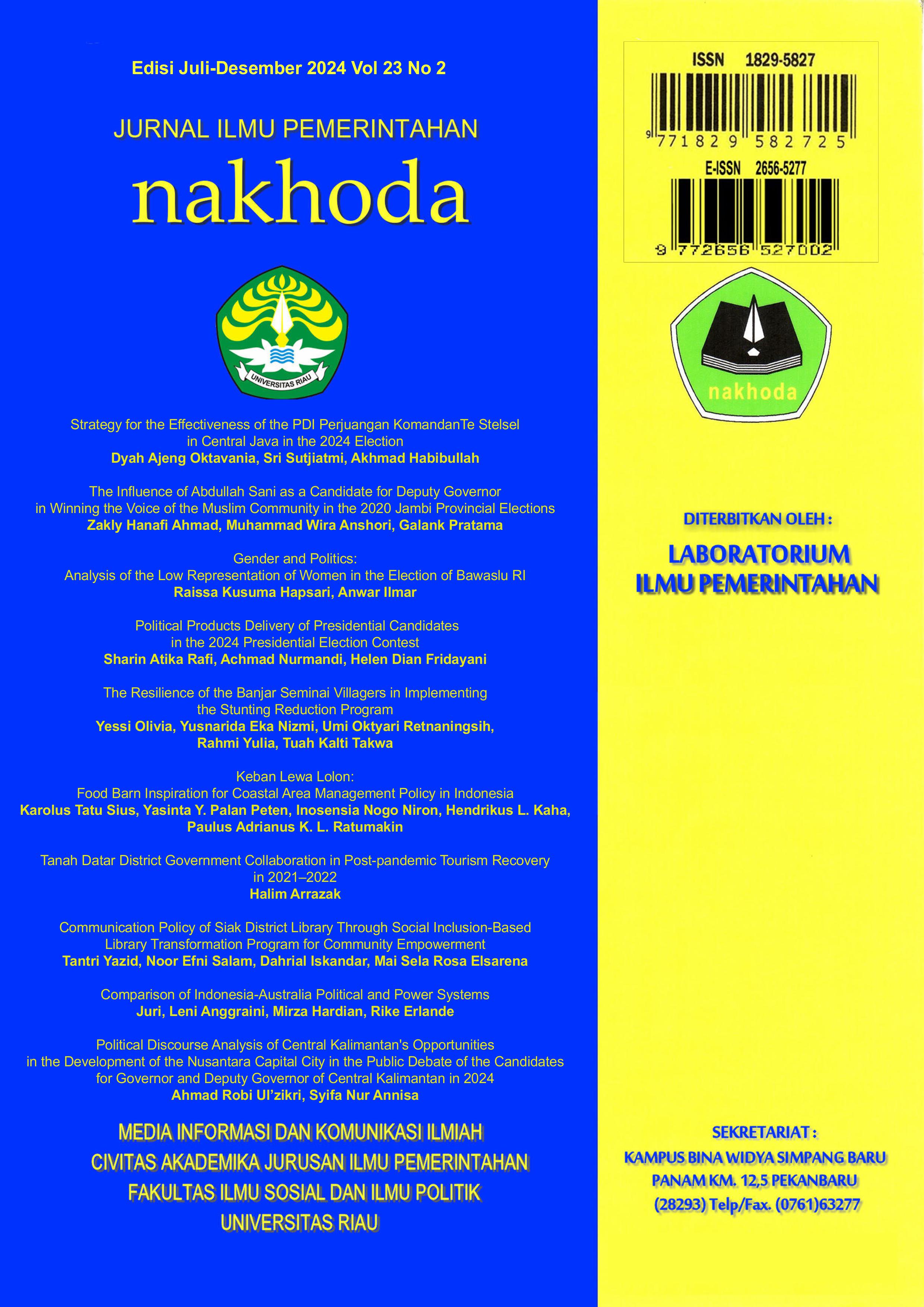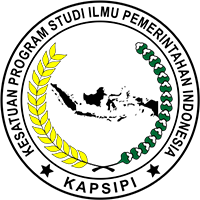The Resilience of the Banjar Seminai Villagers in Implementing the Stunting Reduction Program
DOI:
https://doi.org/10.35967/njip.v23i2.753Keywords:
Stunting, Stunting Prevalence, Community Resilience, Sustainable Development GoalsAbstract
This study aims to analyze how a community manages its resources to address the issue of stunting, which is defined as impaired growth in children due to chronic malnutrition and repeated infections (based on Indonesian Presidential Regulation No. 72 of 2021). Stunting is a serious problem that affects both the physical and psychological development of children. The community studied is Kampung Banjar Seminai, Dayun District, Siak Regency, which claims to have successfully reduced stunting rates in 2023. This is notable because, while the overall stunting rate in Siak Regency slightly increased by 0.33% between 2013 and 2023, the rate in Riau Province dropped significantly from 36.8% to 14% during the same period. The research method involved interviews with people actively involved in tackling stunting at the village level, including the village head, village health workers, and Posyandu volunteers. The results show that the community’s ability to manage resources, along with active participation and good coordination among village actors, played a key role in reducing stunting in Kampung Banjar Seminai. This study highlights the importance of local community involvement in stunting prevention programs and recommends strengthening support and empowering resources at the village level to improve health intervention outcomes.
Downloads
References
Adha, B. A. (2023, December 20). RAPP Berikan Bantuan Alat Kesehatan bagi 8 Puskesmas di Siak. ANTARA News Riau. https://riau.antaranews.com/berita/356889/rapp-berikan-bantuan-alat-kesehatan-bagi-8-puskesmas-di-siak
Aldrich, D. P. (2017). The Importance of Social Capital in Building Community Resilience. In W. Yan & W. Galloway (Eds.), Rethinking Resilience, Adaptation and Transformation in a Time of Change (pp. 357–364). Springer International Publishing. https://doi.org/10.1007/978-3-319-50171-0_23
Basri, H., Hadju, V., Zulkifli, A., Syam, A., Ansariadi, Stang, Indriasari, R., & Helmiyanti, S. (2021). Dietary Diversity, Dietary Patterns and Dietary Intake Are Associated With Stunted Children in Jeneponto District, Indonesia. Gaceta Sanitaria, 35, S483–S486. https://doi.org/10.1016/j.gaceta.2021.10.077
Beal, T., Tumilowicz, A., Sutrisna, A., Izwardy, D., & Neufeld, L. M. (2018). A Review of Child Stunting Determinants in Indonesia. Maternal & Child Nutrition, 14(4), e12617. https://doi.org/10.1111/mcn.12617
Bekhet, A. K., & Zauszniewski, J. A. (2012). Methodological Triangulation: An Approach to Understanding Data. Nurse Researcher, 20(2), 40–43. https://doi.org/10.7748/nr2012.11.20.2.40.c9442
BRIN. (2023, November 30). BRIN Ungkap Prevalensi Stunting di Indonesia Cenderung Fluktuatif. BRIN. https://brin.go.id/news/116962/brin-ungkap-prevalensi-stunting-di-indonesia-cenderung-fluktuatif
Coles, E., & Buckle, P. (2004). Developing Community Resilience as a Foundation for Effective Disaster Recovery. The Australian Journal of Emergency Management, 19(4), 6–15.
Dawes, S. S., Cresswell, A. M., & Cahan, B. B. (2004). Learning From Crisis: Lessons in Human and Information Infrastructure From the World Trade Center Response. Social Science Computer Review, 22(1), 52–66. https://doi.org/10.1177/0894439303259887
Department for International Development. (2011). Defining Disaster Resilience: A DFID Approach Paper. Department for International Development.
Department of Economic and Social Affairs. (n.d.). Goal 2 | End Hunger, Achieve Food Security and Improved Nutrition and Promote Sustainable Agriculture. United Nations. Retrieved July 2, 2025, from https://sdgs.un.org/goals/goal2#targets_and_indicators
Ernawati, F., Syauqy, A., Arifin, A. Y., Soekatri, M. Y. E., & Sandjaja, S. (2021). Micronutrient Deficiencies and Stunting Were Associated with Socioeconomic Status in Indonesian Children Aged 6–59 Months. Nutrients, 13(6), 1802. https://doi.org/10.3390/nu13061802
Hadi, H., Fatimatasari, F., Irwanti, W., Kusuma, C., Alfiana, R. D., Asshiddiqi, M. I. N., Nugroho, S., Lewis, E. C., & Gittelsohn, J. (2021). Exclusive Breastfeeding Protects Young Children from Stunting in a Low-Income Population: A Study from Eastern Indonesia. Nutrients, 13(12), 4264. https://doi.org/10.3390/nu13124264
Keino, S., Plasqui, G., Ettyang, G., & van den Borne, B. (2014). Determinants of Stunting and Overweight among Young Children and Adolescents in Sub-Saharan Africa. Food and Nutrition Bulletin, 35(2), 167–178. https://doi.org/10.1177/156482651403500203
Mahmudiono, T., Sumarmi, S., & Rosenkranz, R. R. (2017). Household Dietary Diversity and Child Stunting in East Java, Indonesia. Asia Pacific Journal of Clinical Nutrition, 26(2), 317–325. https://doi.org/10.6133/apjcn.012016.01
Manik, M. K. W. K. (2022, February 22). Potensi Kerugian Ekonomi akibat ”Stunting” Capai Rp 450 Triliun Per Tahun. Kompas.Id. https://www.kompas.id/baca/humaniora/2022/02/22/potensi-kerugian-ekonomi-akibat-stunting-capai-rp-450-triliun-per-tahun
Myatt, M., Khara, T., Schoenbuchner, S., Pietzsch, S., Dolan, C., Lelijveld, N., & Briend, A. (2018). Children Who Are Both Wasted and Stunted Are Also Underweight and Have a High Risk of Death: A Descriptive Epidemiology of Multiple Anthropometric Deficits Using Data From 51 Countries. Archives of Public Health, 76(1), 28. https://doi.org/10.1186/s13690-018-0277-1
Norris, F. H., Stevens, S. P., Pfefferbaum, B., Wyche, K. F., & Pfefferbaum, R. L. (2008). Community Resilience as a Metaphor, Theory, Set of Capacities, and Strategy for Disaster Readiness. American Journal of Community Psychology, 41(1–2), 127–150. https://doi.org/10.1007/s10464-007-9156-6
Prendergast, A. J., & Humphrey, J. H. (2014). The Stunting Syndrome in Developing Countries. Paediatrics and International Child Health, 34(4), 250–265. https://doi.org/10.1179/2046905514Y.0000000158
Rah, J. H., Sukotjo, S., Badgaiyan, N., Cronin, A. A., & Torlesse, H. (2020). Improved Sanitation Is Associated With Reduced Child Stunting Amongst Indonesian Children Under 3 Years of Age. Maternal & Child Nutrition, 16(S2). https://doi.org/10.1111/mcn.12741
Rasyid, A. (2022, June 24). Pemkab Siak dan PT RAPP MoU Percepatan Penurunan Angka Stunting. Diskominfo Siak. https://diskominfo.siakkab.go.id/pemkab_siak_dan_pt_rapp_mou_percepatan_penurunan_angka_stunting
Rodriguez-Llanes, J. M., Vos, F., & Guha-Sapir, D. (2013). Measuring Psychological Resilience to Disasters: Are Evidence-Based Indicators an Achievable Goal? Environmental Health, 12(1), 115. https://doi.org/10.1186/1476-069X-12-115
Southwick, S. M., Bonanno, G. A., Masten, A. S., Panter-Brick, C., & Yehuda, R. (2014). Resilience Definitions, Theory, and Challenges: Interdisciplinary Perspectives. European Journal of Psychotraumatology, 5(1). https://doi.org/10.3402/ejpt.v5.25338
Statistics of Siak Regency. (2024). Dayun District in Figures 2024. Statistics of Siak Regency. https://siakkab.bps.go.id/id/publication/2024/09/26/0e05d58e6d073d42febc3399/kecamatan-dayun-dalam-angka-2024.html
Sugiyanto, J., Raharjo, S. S., & Dewi, Y. L. R. (2019). The Effects of Exclusive Breastfeeding and Contextual Factor of Village on Stunting in Bontang, East Kalimantan, Indonesia. Journal of Epidemiology and Public Health, 4(3), 222–233. https://doi.org/10.26911/jepublichealth.2019.04.03.10
Titaley, C. R., Ariawan, I., Hapsari, D., Muasyaroh, A., & Dibley, M. J. (2019). Determinants of the Stunting of Children Under Two Years Old in Indonesia: A Multilevel Analysis of the 2013 Indonesia Basic Health Survey. Nutrients, 11(5), 1106. https://doi.org/10.3390/nu11051106
Torlesse, H., Cronin, A. A., Sebayang, S. K., & Nandy, R. (2016). Determinants of Stunting in Indonesian Children: Evidence From a Cross-Sectional Survey Indicate a Prominent Role for the Water, Sanitation and Hygiene Sector in Stunting Reduction. BMC Public Health, 16(1), 669. https://doi.org/10.1186/s12889-016-3339-8
UNICEF, WHO, & World Bank Group. (2023). Levels and Trends in Child Malnutrition. UNICEF/WHO/World Bank Group.
Utami, R. A., Setiawan, A., & Fitriyani, P. (2019). Identifying Causal Risk Factors for Stunting in Children Under Five Years of Age in South Jakarta, Indonesia. Enfermería Clínica, 29, 606–611. https://doi.org/10.1016/j.enfcli.2019.04.093
WHO. (2014). Comprehensive Implementation Plan on Maternal, Infant and Young Child Nutrition. In WHO. WHO. https://www.who.int/publications/i/item/WHO-NMH-NHD-14.1
WHO. (2015, November 19). Stunting in a Nutshell. WHO. https://www.who.int/news/item/19-11-2015-stunting-in-a-nutshell
WHO. (2016). Childhood Stunting: Context, Causes and Consequences. In WHO. WHO. https://www.who.int/publications/m/item/childhood-stunting-context-causes-and-consequences-framework
Woldehanna, T., Behrman, J. R., & Araya, M. W. (2017). The Effect of Early Childhood Stunting on Children’s Cognitive Achievements: Evidence From Young Lives Ethiopia. The Ethiopian Journal of Health Development, 31(2), 75–84.
Wulff, K., Donato, D., & Lurie, N. (2015). What Is Health Resilience and How Can We Build It? Annual Review of Public Health, 36(1), 361–374. https://doi.org/10.1146/annurev-publhealth-031914-122829
Downloads
Published
How to Cite
Issue
Section
License
Copyright (c) 2024 Author(s)

This work is licensed under a Creative Commons Attribution-NonCommercial-ShareAlike 4.0 International License.





